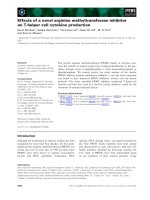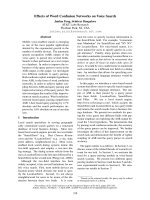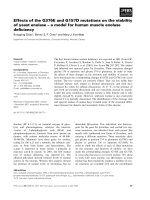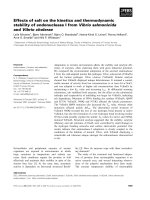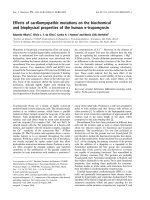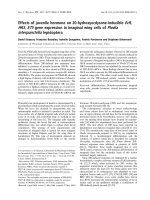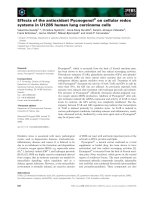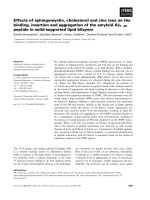Báo cáo khoa học: "Effects of radiation therapy on tissue and serum concentrations of tumour associated trypsin inhibitor and their prognostic significance in rectal cancer patients" doc
Bạn đang xem bản rút gọn của tài liệu. Xem và tải ngay bản đầy đủ của tài liệu tại đây (3.83 MB, 10 trang )
RESEARC H Open Access
Effects of radiation therapy on tissue and serum
concentrations of tumour associated trypsin
inhibitor and their prognostic significance in
rectal cancer patients
Alexander Gaber
1
, Christina Stene
2
, Kristina Hotakainen
3
, Björn Nodin
1
, Ingrid Palmquist
2
, Anders Bjartell
4,5
,
Ulf-Håkan Stenman
3
, Bengt Jeppsson
2
, Louis B Johnson
2
and Karin Jirström
1*
Abstract
Background: We have previously demonstrated that elevated concentrations of tumour-associated trypsin inhibitor
(TATI) in both tumour tissue (t-TATI) and in serum (s-TATI) are associated with a poor prognosis in colorectal cancer
patients. It was also found that s-TATI concentrations were lower in patients with rectal cancer compared to
patients with colon cancer. In this study, we investigated the effects of neoadjuvant radiotherapy (RT) on
concentrations of t-TATI and s-TATI in patients with rectal cancer.
Methods: TATI was analysed in serum, normal mucosa and tumour tissue collect ed at various time points in 53
rectal can cer patients enrolled in a case-control study where 12 patients received surgery alone, 20 patients 5 × 5
Gy (short-term) preoperative RT and 21 patients 25 × 2 Gy (long-term) preoperative RT. T-TATI was analysed by
immunohistochemistry and s-TATI was determined by an immunofluorometric assay. Mann-Whitney U test and
Wilcoxon Z (Z) test were used to assess t-TATI and s-TATI concentrations in relation to RT. Spearman’s correlation
(R) test was used to explore the associations between t-TATI, s-TATI and clinicopathological parameters. Overall
survival (OS) according to high and low t-TATI and s-TATI concentrations was estimated by classification and
regression tree analysis, Kaplan-Meier analysis and the log rank test.
Results: RT did not affect concentrations of t-TATI or s-TATI. In patients receiving short-term but not long-term RT,
s-TATI concentrations were significantly higher 4 weeks post surgery than in serum drawn prior to surgery (Z =
-3.366, P < 0.001). T-TATI expression correlated with male gender (R = 0.406, P = 0.008). High t-TATI expression in
surgical specimens was associated with a significantly shorter OS (P = 0.045). S-TATI concentrations in serum drawn
at all time points were associated with an impaired OS (P = 0.035 before RT, P = 0.001 prior to surgery, P = 0.043
post surgery). At all time points, s-TATI correlated with higher ag e (P < 0.001-0.021) and with increased s-creatinine
concentrations assessed prior to surgery (P = 0.041).
Conclusions: The results presented here further validate the utility of t-TATI and s-TATI as prognostic biomarkers in
patients with rectal cancer, independent of neoadjuvant RT.
Keywords: Rectal cancer, tissue micro array, TATI, radio ther apy, prognosis, biomarker
* Correspondence:
1
Department of Clinical Sciences, Division of Pathology, Lund University,
Skåne University Hospital, Lund, Sweden
Full list of author information is available at the end of the article
Gaber et al. Radiation Oncology 2011, 6:100
/>© 2011 Gaber et al; licensee BioMed Central Ltd. This is an Open Access article distributed under the terms of the Creative Commons
Attribution License ( which permits unre stricted use, distribution, and reproduction in
any medium, provided the original work is properly cited.
Background
We have previously demonstrated tha t tumour-asso-
ciated trypsin inhibitor (TATI),alsocalledpancreatic
secretory trypsin inhibitor (PSTI) and serine protease
inhibitor Kazal type 1 (SPINK1), is a biomarker of poor
prognosis in colorectal cancer patients, both as assessed
in tumour tissue (t-TATI) [1] and in serum (s-TATI)
[2], whereby the strongest independent prognostic value
was seen for s-TATI [2]. While there was no association
between t-TATI and tumour location, s-TATI concen-
trations were significantly lower in patients with rectal
cancer compared t o those with colon cancer [2]. This
could be due to biological differences between colonic
and rectal tumours, but as the majority of the rectal
cancer patients in the study (85/107) had received
neoadjuvant radiotherapy (RT), we could not exclude
the possibility that RT affects s-TATI concentrations in
rectal cancer patients.
For patients with rectal cancer, preoperative RT has
been found to significantly reduce the risk for local
recurrence and death [3,4]. Studies on the effects of RT
on rectal tumour tissue have shown that tumour cells
become swollen and that the stro mal compartment
acquires an abundance of fibroblasts, granulocytes and
lymphocytes [5]. Ionising radiation induces a widespread
oxidative d amage at the cellular level [6] and has been
found to remodel the extracellular mat rix (ECM) and
affect various enzymes such as transforming growth fac-
tor receptor beta 1 (TGF-ß1), matrix metalloproteinase
2 ( MMP-2) and MMP-9 [7]. Urokinase-type plasmino-
gen activator (uPA), and other members of the serpin
family like plasminogen activator inhibitor 1 (PAI-1),
have also been found to play important roles in the
remodelling of ECM [5].
Trypsin is a potent matrix serine protease (MSP) that
hydrolyses a v ariety of proteins and activates ot her
MSPs and MMPs [ 8,9]. TATI is a trypsin inhibitor that
balances concentrations of trypsin and al so functions as
a weak inhibitor of other serine proteinases [10,11]. In
addition, TATI has been found to be involved in tissue
repair in vitro [12] and to play an i mportant role in the
tumour microenvironment and tumour cell invasion
[13]. In the light of these findings, it could be hypothe-
sized that RT in rectal cancer affects TATI concentra-
tions in tissue and/or serum and, he nce, survival. As we
are not aware of any previous studies describing the
effects of RT on the tumour-specific expression of TATI
or its s erum concentrations in any cancer form, the aim
of the present study was to investigate whether neoadju-
vant RT affects t-TATI and s-TATI concentrations in
rectal cancer patients, and to assess their prognostic
values. For this purpose, TATI was analysed in serum,
non-malignant rectal mucosa and tumour tissue samples
taken at different t ime points; before, during, and aft er
RT, and for serum a lso 4 weeks after surgery, in a pro-
spective cohort of 53 patients with rectal cance r. Given
the p reviously observed association between higher age
and increased s-TATI concentrations [2], we also exam-
ined the relationship between t-TATI, s-TATI, age, and
the concentrations of s-creatinine and carcinoembryonic
antigen (s-CEA) in preoperatively drawn serum samples.
Methods
Patients
Thestudywasdesignedasacase-controlstudyand
consisted of 77 patients diagnosed and treated for rectal
cancer at Skåne University Hospital, Malm ö, between
2003 and 2007. A total number of 24 patients were
excluded, 8 for whom the diag nosis was revised to hig h
grad e dysplasia, 8 due to an impaired general condition,
3 patients with synchronous tumours in the colon, 4
patients who declined to participate, and 1 patient was
excluded due to logistic reasons. Thus, the study cohort
compris ed 53 patien ts, 36 (67.9%) males and 17 (32.1%)
females. Patients were staged according to the TNM
system (American Joint Committee on Cancer, AJCC,
6
th
edition) [14]. One group rec eived short-term regi-
men of preoperative RT (25 Gy; n = 20, 37.7%), another
group received long-term regimen of preoperative RT
(50 Gy, n = 21, 39.6%), and a control group underw ent
surge ry alone (n = 12, 22.6%). Patient and tum our char-
acteristics according to treatment groups are shown in
Table 1. Serum and tissue samples were collected from
the three different groups at different time points. From
non-irradiated patients and the short-term RT group,
serum was drawn on three occasions; b efore RT, after
RT (prior to surgery), and at routine follow-up 4 weeks
post surgery. In the long-term RT group, serum was col-
lected at two additional occasions; 12 days into RT (at
half-time) and after completion of treatment. No
patients received neoadjuvant chemotherapy. Thirteen
patients (24.5%) received adjuvant chemotherapy after
surgery. Se rum samples were stored at -20°C until ana-
lysis. Tissue biopsies, both from tumour and normal
mucosa, were sampled at the same time points as
serum, except at follow-up 4 weeks post-surgery (Addi-
tional file 1). Tissue samples were formalin fixated and
paraffin em bedded. The study has been approved by the
Ethics committee at Lund University (ref 144/2004 with
amendment 597/2006) and written consent was
obtained from the patients.
Tissue microarrays
Two tissue microarray (TMA) series were constructed;
one biopsy TM A with 1 × 1 mm cores from biopsies
with normal tissue (sampled 2 cm from the tumour)
and cancer, respectively, and one TMA with normal and
cancerous tissue from the surgical speci mens, whereby 2
Gaber et al. Radiation Oncology 2011, 6:100
/>Page 2 of 10
× 1 mm cores were extracted from areas representing
viable, non-necrotic tumour, and adjacent, microscopi-
cally benign, rectal mucosa, respectively.
Immunohistochemistry and staining evaluation
Four-micrometer sections from the TMAs were pre-
treated in the DAKO PT-linkmoduleusingastandard
protocol and buffer supplied by the manufacturer. Slides
were then staine d in a DAKO Autostainer-plus using
the EnVision™ FLEX including Peroxidise-Blocking
Reagent (DAKO, Glostrup, Denmark) with a TATI
monoclonal antibody (6E8) diluted 1:150 as described
earlier [15]. In line with previous findings [1], TATI was
expressed in the cytoplasm, and the percentage of posi-
tive tumour cells was estimated separately in each core.
Intensity was annotated using a scale from 0-3. The
immunohistoche mical staining was evaluated indepen-
dentlytwicebyoneobserver(AG).Foreachcase,a
mean score from both cores was calculated, as well as,
wherever possible, the best score [1].
Immunofluorometric assay of s-TATI
Samples were analysed using a time-resolved immuno-
fluorometric assay, with the MAb 6E8 as a capture anti-
body for TATI and a europium (Eu) labelled antibod y
11B3 as a tracer [2,15]. Flu orescence was measured with
a 1420 VIKTOR2 time-resolved fluorometer (Wallac,
Turku, Finland), where the lower l imit of detection for
TATI was 0.1 μg/L and the measu ring range 0.5-90 μg/
L.
Statistical analysis
Comparison of TATI concentr ations in tissue and
serum at different time points in patient subgroups
receiving no preoperative RT, short-term RT an d long-
term RT was performed using the Mann-Whitney U-
test and Wilcoxon Z test (Z). Spearman’s correlation (R)
test was used to explore the ass ociations between t-
TATI and s-TATI concentrations, before and after RT,
and clinicopathological parameters, including s-CEA and
s-creatinine. Classification and regression tree (CRT)
analysis was used to assess optimal cut-offs for t-TATI
and s-TATI i n relation to OS. Kaplan-Meier analysis
and log-rank tests were applied to compare survival in
strata according to low and high concentrations of t-
Table 1 Patient characteristics
No RT Short-term
RT
Long-term
RT
p-
value
n(%) 12 20 21
Age
< 75 8(66.7) 15(75.0) 16(76.2)
≥ 75 4(33.3) 5(25.0) 5(23.8)
Missing 0(0) 0(0) 0(0) 0.823
Gender
male 9(75.0) 14(70.0) 13(61.9)
female 3(25.0) 6(30.0) 8(38.1)
Missing 0(0) 0(0) 0(0) 0.717
Differentiation
grade
Well-Moderate 12
(100.0)
13(65.0) 17(81.0)
Low 0(0) 6(30.0) 2(9.5)
Missing 0(0) 1(5.0) 2(9.5) 0.107
T-stage
I 0(0) 1(5.0) 1(4.8)
II 5(41.7) 7(35.0) 4(19.0)
III 6(50.0) 12(60.0) 11(52.4)
IV 1(8.3) 0(0) 3(14.3)
Missing 0(0) 0(0) 2(9.5) 0.421
N-stage
0 7(58.3) 10(50.0) 11(52.4)
I 2(16.7) 3(15.0) 7(33.3)
II 3(25.0) 7(35.0) 1(4.8)
Missing 0(0) 0(0) 2(9.5) 0.144
M-stage
0 11(97.7) 18(90.0) 19(90.5)
I 1(8.3) 2(10.0) 1(4.8)
Missing 0(0) 0(0) 1(4.8) 0.752
Disease stage
Stage I 3(25.0) 7(35.0) 4(19.0)
Stage II 4(33.3) 3(15.0) 7(33.3)
Stage III 4(33.3) 8(40.0) 7(33.3)
Stage IV 1(8,3) 2(10.0) 1(4.8)
Missing 0(0) 0(0) 2(9.5) 0.628
Operative
procedure
Rectum resection 9(75.0) 11(55.0) 9(42.9)
Rectum amputation 2(16.7) 8(40.0) 8(38.1)
Hartmann’s
procedure
1(8.3) 1(5.0) 3(14.3)
Missing 0(0) 0(0) 1(4.8) 0.506
Table 1 Patient characteristics (Continued)
Vascular invasion
No 9(75.0) 14(70.0) 14(66.7)
Yes 3(25.0) 6(30.0) 5(23.8)
Missing 0(0) 0(0) 2(9.5) 0.125
Gaber et al. Radiation Oncology 2011, 6:100
/>Page 3 of 10
TATI and s-TATI derived from the CRT analysis. P-
values of < 0.05 were considered sign ificant. Only two-
sided results were used. Statistical analyses were carried
out using the Statistical Package for S ocial Sciences,
SPSS 16.0 package (SPSS Inc, Chicago, Ill).
Results
TATI concentrations in tumour tissue, normal mucosa,
and serum in relation to radiotherapy
In line with previous findings [1], TATI expression in
tumour cells was variable and less abundant than in
normal mucosal cells. There was no obvious heteroge-
neity in t-TATI expression across duplicate cores,
which is in line with previous findings [1]. Using a mul-
tipl ier of fraction and intensity, there was no significant
difference between TATI expression in tumour tissue
collected prior to RT and after RT (Figure 1A) nor in
biopsies taken during RT (n = 8, data not shown), with
similar findings in norm al mucosa (Figure 1B). In surgi-
cally resected tumour specimens, there was no signifi-
cant difference in t-TATI expression between the
diff erent tre atment groups (data not shown). There was
no significant difference in s-TATI concentrations
between samples drawn before, during and after RT in
any treatment group (Figure 2A-D). The median s-
TATI concentration prior to surgery was 9.06 μg/L
(range 4.28-62.49 μg/L). In patients t reated with the
short-term RT regimen, significantly higher s-TATI
concentrations were found in serum drawn post-opera-
tively compared to serum drawn prior to RT or prior to
surgery(Z=-3.366,P<0.001;Figure2C).Inpatients
treated with long-term RT regimen, there was no signif-
icant difference in post-operative s-TATI concentrations
compared to earlier time points (P = 0.150). The post-
operative increase in s-TATI was higher in patients
with Stage III-IV (Z = -2.994, P = 0.003) disease than in
with patients with Stage I-II disease (Z = -2.556, P
0.011) (Figure 2E-F). There was no significant difference
in s-TATI concentrations in serum drawn at follow-up
in patients receiving adjuvant chemotherapy compared
to patients not receiving adjuvant chemotherapy (data
not shown).
Association between TATI in tissue and serum and
clinicopathological characteristics
T-TATI expression in biopsies extracted before RT did
not show any correlation to clinicopathological charac-
teristics; age, gender, disease stage, differentiation or
vascular invasion (Table 2). In tumour tissue obt ained
from surgery, TATI expression correla ted significantly
with male gender (R = 0.406, P = 0.008) and also with
disease stage (R = 0.331, P = 0.033).
There was a significant association between age and s-
TATI concentrations prior to RT (R = 0.586, P < 0.001)
and after RT (R = 0.453, P = 0.001) and a significant
association between s-TATI concentrations prior to sur-
gery and a more advanced disease stage (R = 0.338, P =
0.021)(Table 2). In line with previous findings, there was
no significant correlation between t-TATI and s-TATI
[2]. There was no significant association between s-
TATI or t-TATI and s-CEA (data not shown). In gen-
eral, while t-TATI concentrations in biopsies and in tis-
sue from surgery did not correlate with each other,
there was a significant correlation between s-TATI con-
centrations in samples drawn at the different time
points (data not shown). In order to explore whether
the association between elevated s-TATI concentrations
and increased age can be attributed to an impaired renal
function, we analysed the association between s-TATI,
and s-creatinine drawn prior to surgery. S-TATI con-
centrations in serum before RT and prior to surgery
showed a modest correlation with s-creatinine (R =
Figure 1 TATI expression in tumour tissue and normal mucosa
before and after radiotherapy. Box plots showing TATI expression
levels in tumour tissue before and after RT (A), and in normal
mucosal tissue before and after RT (B), in RT treated patients.
Gaber et al. Radiation Oncology 2011, 6:100
/>Page 4 of 10
0.369, P = 0.011, R = 0.302, P = 0.041 respe ctively)
(Table 2). There was no significant association b etween
s-TATI at follow-up and s-creatinine (data not shown)
and t-TATI expression was not associated to s-
creatinine concentrations (data not shown). There was
no significant association between age and s-creatinine
(data not shown) and no significant difference i n t-
TATI or s-TATI concentrations in patie nts treated with
Figure 2 TATI concentrations in serum at differe nt time points. Box plots showing s-TATI levels at different time points for; all patients (A),
RT subgroups (B-D) and in dichotomized stage subgroups (E-F).
Gaber et al. Radiation Oncology 2011, 6:100
/>Page 5 of 10
adj uvant chemotherapy (n = 13) compared to untreated
patients (data not shown).
Prognostic value of TATI in tissue and serum
ROC c urve analysis, showed a trend, however non-sig-
nificant, between higher t-TATI expression (multiplier)
and an adverse OS (AUC = 0.655, P = 0.0779; Figure
3A) . ROC curve analysis further revealed that the prog-
nostic value of s-TATI was stronger at all time points
(before RT; AUC = 0.668, P = 0.0418, prior to surgery;
AUC = 0.757, P < 0.001, at follow-up; AUC = 0.777, P =
0.0047; Figure 3B). According to the result of the CRT
analysis, a t-TATI fraction-intensity multiplier cut-off at
2.4 was adopted, where levels > 2.4 were considered to
denote strong expression (CRT; Additional file 2A). S-
TATI cut-offs based on the CRT analysis of preopera-
tively drawn samples was set to 7.70 μg/L (Additional
file 2B), and in serum drawn p rior to surgery; 7.38 μg/L
(Additional file 2C). The cut-off for s-TATI collected at
follow-up was set to 10.74 μg/L, and to 2. 6 μg/L for s-
CEA. Kaplan-Meier analysis and the log rank test
revealed that t-TATI expression in bi opsies sampled
before RT had no prognostic value (Figure 4A), while a
high t-TATI expression in surgical specimens (P =
0.045; Figure 4B) and high s-TATI concentrations
before RT (P = 0,035; Figure 4C) and prior to surgery
(P = 0.001; Figure 4D), were significantly associated with
a shorter OS.
Discussion
The results from this study show that neoa djuvant RT
does not affect TATI concentrations in tissue or serum
in re ctal cancer patients, and that both, in partic ular s-
TATI, a re factors of poor prognosis, further validating
previous findings [1,2]. There were no significant differ-
ences in t-TATI or s-T ATI concentrations in any treat-
ment group, neither when the groups were analysed
separately nor when TATI concentrations were com-
pared at different time points; before, during and after
treatment. Hence, the previously observed lower s-TATI
concentrations in patients with rectal compared to
colon cancer patients [2] are unlikely due to effects of
neoadjuvant RT. In our previous study, s-TATI concen-
trations were also found to be significantly higher in
right-sided than left-sided colonic cancers [2]. This may
indicate that differences in s-TATI concentrations are
related to biological characteristics associated with dif-
ferent tumour locations. In contrast, t-TATI expression
Table 2 Correlations between t-TATI/s-TATI and clinicopathological characteristics
t-TATI(f*i) s-TATI(μg/L)
Pre RT After RT(OP) Before RT After RT
Age at OP
R -0,007 0,114 0,586 0,453
p 0,970 0,474 < 0,001* 0,001*
n33425651
Gender
R -0,214 -0,406 0,011 -0,167
p 0,232 0,008* 0,94 0,241
n33425251
Disease stage
R 0,066 0,330 0,057 0,338
p 0,720 0,033* 0,703 0,021*
n31424746
Vascular invasion
R 0,204 -0,062 -0,165 -0,053
p 0,262 0,695 0,268 0,725
n32424736
s-kreatinin drafted preOP
R 0,170 0,038 0,369 0,302
p 0,346 0,812 0,011* 0,041*
n33414746
* R: Spearman’s correlations coefficient. P < 0.005 n: number of correlated samples.
Gaber et al. Radiation Oncology 2011, 6:100
/>Page 6 of 10
did not differ according to tumour location [2]. Along
this line, as no significant association could be found
between t-TATI and s-TATI concentrations neither in
this nor in the previous study [2], it could be speculated
that TATI concentrations in tumour tissue and serum
in CRC patients reflect different biological aspects of the
disease.
Further results revealed that t-TATI expression in the
surgically resected specimens were significantly higher
in males than in females. Interestingly, re-analysis of
data from o ur previous study on t-TATI [1] revealed a
signi ficant association between male gender and t-TATI
concentrations (n = 105, R = 0.196, P = 0.045) in
patients with rectal cancer, but not in patients with
colon cancer. Notably, in the present study, there was
no significant association betweenTATIexpressionin
tumour biopsies sampled before RT and gender, but this
was possibly due to the smaller number of cases avail-
able for analysis. These results could however also
reflect a more representative sampling of tissue from the
Figure 3 Prognostic value of TATI concentrations in tumour tissue and serum. ROC curves showing estimations of the prognostic value of
t-TATI in surgically obtained tissue (A) and s-TATI drawn at different time points (B).
Gaber et al. Radiation Oncology 2011, 6:100
/>Page 7 of 10
surgically resected specimens. Discrepant immunohisto-
chemical staining results between biopsies and full tissue
sections have been reported [16].
As ma le gender is a ssociated with an increased mor-
tality from colorectal cancer [17], and TATI has been
associated with a more aggressive tumo ur phenotype
[13], it could be speculated that males to a larger extent
have more aggressive tumour forms, with higher TATI
expression. This hypothesis does however not explain
why s-TATI concentrations were not associated with
gender, neither in the present nor in our previous study
[2], and in both studies, s-TATI was a stronger prognos-
tic factor than t-TATI.
There were significant associations between s-TATI,
but not t-TATI, and age at diagnosis, in serum drawn at
all time points in this study, which is in line with our pre-
vious findings [2]. As we found a significant association
between higher s-TATI concentrations and s-creatinine,
this could in part be explained by an impaired renal func-
tion in elderly patients, which is in line with previous
find ings demonstrating an association between increased
s-TATI concentrations and an impaired renal function
[18]. Notably, s-creatinine concentration levels were not
available for the patients included in the previous study
on s-TATI [2], and although the sample size in this study
is too small to draw any firm conclusions, s-creatinine
should be taken int o consideration in future studies on
the role of s-TATI as a prognostic biomarker in CRC.
For s-TATI, the optimal cut-off s derived f rom CRT ana-
lyses were identical to optimal cut-offs according to ROC
curve analyses and s-TATI remained prognostic also
when higher cut-offs were used in the survival analyses.
The median concentration level of s-TAT I was lower in
the present study (9.06 μg/L) than in the previous study
on colorectal cancer patients (median; 13.42 μg/L), where
colon cancer patients had significantly higher s-TATI
Figure 4 Kaplan-Meier estim ates of overall surviva l according to TATI concentrations in tumour tissue and serum. Kaplan-Meier plots
showing overall survival according to high and low levels of t-TATI; before RT (A), after RT (B) and for s-TATI; before RT (C), after RT (D).
Gaber et al. Radiation Oncology 2011, 6:100
/>Page 8 of 10
levels (14.62 μg/L) than rectal cancer patients (median;
12.48 μg/L) [2]. Hence, the cut-offs derived from CRT
analysis were slightly lower in this study.
Higher TATI concentrations in serum drawn prior to
surgery correlated with disease stage, which is in line
with our previous study [2]. There was also a significant
association between higher t-TATI expression in the
surgical specimens, but notinbiopsies,andamore
advanc ed disease stage. In our prev ious study there was
no significant association between t-TATI and clinical
stage, neither in the full cohort nor in rectal cancer
patients [1]. The lack of an association between t-TATI
and s-TATI with s-CEA concentrations is also in line
with previous findings [2]. We are not aware of any
other studies on the effect of RT on TATI concentra-
tions in tissue or serum, but studies on another protease
inhibitor; tissue inhibitor of metalloproteinase 1 (TIMP-
1), have shown that the expressionintumourtissueis
unaffected by RT [5,19 ]. However, plasma concentra-
tions of TIMP-1 have been found to increase after com-
bined RT-chemotherapy treatment [20]. Interestingly,
we found a significant post-operative increase in s-TATI
concentrations in patients treated by short-term RT but
not in long-term RT treated patients. In line with pre-
vious findings, s-TATI concentrations increased consid-
erably after surgery for many of the short-term regimen
treated patients, which supports the theory that TATI
can behave as an acute phase reactant, as demonstrated
by Solakidi et al. [21].
Similarly, in our study s-TATI concentrations
remained largely unaffected throughout RT until sur-
gery in both short-term and long-term RT treated
patients, a nd the elevated concentrations in short term
RT treated patients were only seen 4 weeks post-
surgery.
We did not find any significant differences in s-TATI
concentrations according to adjuvant chemoth erapy and
there was no difference in the distribution of clinico-
pathological characteristics in patients receiving RT and
untreated patients, decrea sing the probability of a
patient selection bias.
Conclusions
In this study, we demonstrate that concentrations of
TATI in tumour tissue or serum are not affected by
neoadjuvant radiotherapy in rectal cancer patients. The
finding of an association between both t-TATI and s-
TATI, in particular the latter, and an impaired survival
is in line with previous results, and further supports the
potential utility of TATI as a prognostic biomarker in
patients with cancer of the colon and r ectum, irrespec-
tive of neoadjuvant RT.
Additional material
Additional file 1: Study design. Flowchart illustrating treatment course
and sample collection in subgroups according to neoadjuvant radio
therapy.
Additional file 2: Classification regression tree charts. Classification
regression trees of t-TATI expression in resected specimen (A), s-TATI
drawn before RT (B) and at surgery (C).
Acknowledgements
This work was supported by grants from the Swedish Cancer Society, the
Knut and Alice Wallenberg Foundation, Gunnar Nilsson’s Cancer Foundation,
the Crafoord Foundation and the Research Funds of Skåne University
Hospital.
Author details
1
Department of Clinical Sciences, Division of Pathology, Lund University,
Skåne University Hospital, Lund, Sweden.
2
Department of Clinical Sciences,
Division of Colorectal Surgery, Lund University, Skåne University Hospital,
Malmö, Sweden.
3
Department of Clinical Chemistry, University of Helsinki
and Helsinki University Central Hospital, Helsinki, Finland.
4
Center for
Molecular Pathology, Department of Laboratory Medicine, Lund University,
Skåne University Hospital, Malmö, Sweden.
5
Department of Clinical Sciences,
Division of Urological Cancers, Lund University, Skåne University Hospital,
Malmö, Sweden.
Authors’ contributions
AG participated in the collection of data, performed statistical analyses and
drafted the manuscript. CS participated in the collection of tissue samples,
data and revised the manuscript. KH performed the serum analyses and
revised the manuscript. IP assisted in the collection of tissue samples and
data. AB participated in the conception of the study, BN assisted with the
TMA construction and revision of the manuscript, UHS participated in
revision of the manuscript, BJ participated in the conception and design of
the study, LBJ participated in the collection of tissue samples, data and
revised the manuscript, KJ participated in the conception and design of the
study, statistical analysis, drafted and revised the manuscript. All authors read
and approved the final manuscript.
Competing interests
The authors declare that they have no competing interests.
Received: 3 May 2011 Accepted: 24 August 2011
Published: 24 August 2011
References
1. Gaber A, Johansson M, Stenman UH, Hotakainen K, Ponten F, Glimelius B,
Bjartell A, Jirstrom K, Birgisson H: High expression of tumour-associated
trypsin inhibitor correlates with liver metastasis and poor prognosis in
colorectal cancer. Br J Cancer 2009, 100:1540-1548.
2. Gaber A, Nodin B, Hotakainen K, Nilsson E, Stenman UH, Bjartell A,
Birgisson H, Jirstrom K: Increased serum levels of tumour-associated
trypsin inhibitor independently predict a poor prognosis in colorectal
cancer patients. BMC Cancer 2010, 10:498.
3. Folkesson J, Birgisson H, Pahlman L, Cedermark B, Glimelius B,
Gunnarsson U: Swedish Rectal Cancer Trial: long lasting benefits from
radiotherapy on survival and local recurrence rate. J Clin Oncol 2005,
23:5644-5650.
4. Improved survival with preoperative radiotherapy in resectable rectal
cancer. Swedish Rectal Cancer Trial. N Engl J Med 1997, 336:980-987.
5. Angenete E, Oresland T, Falk P, Breimer M, Hultborn R, Ivarsson ML:
Preoperative radiotherapy and extracellular matrix remodeling in rectal
mucosa and tumour matrix metalloproteinases and plasminogen
components. Acta Oncol 2009, 1-9.
6. Yarnold J: Molecular aspects of cellular responses to radiotherapy.
Radiother Oncol 1997, 44:1-7.
Gaber et al. Radiation Oncology 2011, 6:100
/>Page 9 of 10
7. Kumar A, Collins HM, Scholefield JH, Watson SA: Increased type-IV
collagenase (MMP-2 and MMP-9) activity following preoperative
radiotherapy in rectal cancer. Br J Cancer 2000, 82:960-965.
8. Koivunen E, Ristimaki A, Itkonen O, Osman S, Vuento M, Stenman UH:
Tumor-associated trypsin participates in cancer cell-mediated
degradation of extracellular matrix. Cancer Res 1991, 51:2107-2112.
9. Yamamoto H, Iku S, Adachi Y, Imsumran A, Taniguchi H, Nosho K, Min Y,
Horiuchi S, Yoshida M, Itoh F, Imai K: Association of trypsin expression
with tumour progression and matrilysin expression in human colorectal
cancer. J Pathol 2003, 199:176-184.
10. Huhtala ML, Pesonen K, Kalkkinen N, Stenman UH: Purification and
characterization of a tumor-associated trypsin inhibitor from the urine of
a patient with ovarian cancer. J Biol Chem 1982, 257:13713-13716.
11. Turpeinen U, Koivunen E, Stenman UH: Reaction of a tumour-associated
trypsin inhibitor with serine proteinases associated with coagulation and
tumour invasion. Biochem J 1988, 254:911-914.
12. Stenman UH: Tumour-associated trypsin inhibitor and tumour-associated
trypsin. Scand J Clin Lab Invest Suppl 1990, 201 :93-101.
13. Gouyer V, Fontaine D, Dumont P, de Wever O, Fontayne-Devaud H,
Leteurtre E, Truant S, Delacour D, Drobecq H, Kerckaert JP, et al: Autocrine
induction of invasion and metastasis by tumor-associated trypsin
inhibitor in human colon cancer cells. Oncogene 2008, 27:4024-4033.
14. Greene F, Page D, Fleming I, et al: AJCC Cancer Staging Manual. 6 edition.
New York: Springer-Verlag; 2002.
15. Osman S, Turpeinen U, Itkonen O, Stenman UH: Optimization of a time-
resolved immunofluorometric assay for tumor-associated trypsin
inhibitor (TATI) using the streptavidin-biotin system. J Immunol Methods
1993, 161:97-106.
16. Goldstein NS, Bosler D: An approach to interpreting
immunohistochemical stains of adenocarcinoma in small needle core
biopsy specimens: the impact of limited specimen size. Am J Clin Pathol
2007, 127:273-281.
17. American_Cancer_Society: Colorectal cancer: facts and figure 2008-1010
18. Tramonti G, Donadio C, Ferdeghini M, Annichiarico C, Norpoth M, Bianchi R,
Bianchi C: Serum tumour-associated trypsin inhibitor (TATI) and renal
function. Scand J Clin Lab Invest 1996, 56:653-656.
19. Unsal Kilic D, Uner A, Akyurek N, Erpolat P, Dursun A, Pak Y: Matrix
metalloproteinase-9 expression correlated with tumor response in
patients with locally advanced rectal cancer undergoing preoperative
chemoradiotherapy. Int J Radiat Oncol Biol Phys 2007, 67:196-203.
20. Aldulaymi B, Christensen IJ, Soletormos G, Jess P, Nielsen SE, Laurberg S,
Brunner N, Nielsen HJ: Chemoradiation-induced changes in serum CEA
and plasma TIMP-1 in patients with locally advanced rectal cancer.
Anticancer Res 30:4755-4759.
21. Solakidi S, Dessypris A, Stathopoulos GP, Androulakis G, Sekeris CE: Tumour-
associated trypsin inhibitor, carcinoembryonic antigen and acute-phase
reactant proteins CRP and alpha1-antitrypsin in patients with
gastrointestinal malignancies. Clin Biochem 2004, 37:56-60.
doi:10.1186/1748-717X-6-100
Cite this article as: Gaber et al.: Effects of radiation therapy on tissue
and serum concentrations of tumour associated trypsin inhibitor and
their prognostic significance in rectal cancer patients. Radiation
Oncology 2011 6:100.
Submit your next manuscript to BioMed Central
and take full advantage of:
• Convenient online submission
• Thorough peer review
• No space constraints or color figure charges
• Immediate publication on acceptance
• Inclusion in PubMed, CAS, Scopus and Google Scholar
• Research which is freely available for redistribution
Submit your manuscript at
www.biomedcentral.com/submit
Gaber et al. Radiation Oncology 2011, 6:100
/>Page 10 of 10

